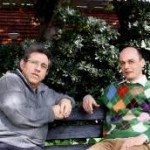cell adhesion
New online articles this week highlight two forays into the world of synthetic biology. Each, in its own way, gives a different perspective on how sophisticated the field has become in the past few years, since smiley-face DNA was first introduced.
Prof. Benjamin Geiger of the Weizmann Institute and Prof. Joachim Spatz of the Max Planck Institute for Intelligent Systems, Germany are leading an unusual collaboration. One is a biologist, the other a materials scientist. Together, they are working on models that incorporate the whole gamut from completely man-made materials to 100% biological…
The autism spectrum disorders (ASDs), including autism and its milder cousin Asperger syndrome, affect about 1 in 150 American children. There's a lot of evidence that these conditions have a strong genetic basis. For example, identical twins who share the same DNA are much more likely to both develop similar autistic disorders than non-identical twins, who only share half their DNA.
But the hunt for mutations that predispose people to autism has been long and fraught. By looking at families with a history of ASDs, geneticists have catalogued hundreds of genetic variants that are linked to…
